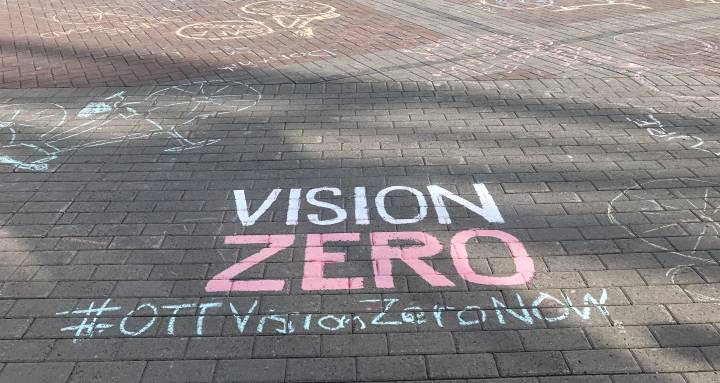
Beatrice Britneff / Global News
Chalk writings adorn the square outside Marion Dewar Plaza at Ottawa city hall. They were written by over 200 cyclists that rode down Laurier Avenue on May 22, 2019, calling for safer cycling infrastructure in Ottawa.
A number of people who use Ottawa’s roads lamented that the City of Ottawa isn’t adopting ‘Vision Zero’ – a program that aims to eliminate all traffic fatalities and severe injuries – in its new road safety action plan for 2020-2024.
“This is a ‘Vision 20 per cent reduction,’” Ecology Ottawa’s executive director Robb Barnes said of the proposed plan.
The new road safety plan – the city’s third – has been two years in the making and was announced by the mayor and transportation committee chair Stephen Blais last week. The third generation of the plan is proposing new initiatives to enhance safety in four main areas – cyclists, pedestrians, high-risk drivers and rural roads – in order to reach its 20 per cent goal by 2024.
Councillors heard the new plan is based on the “safe systems approach,” whose principles include prioritizing human life and health; a “shared responsibility” by roadway users and regulators; that human error on the roads “shouldn’t lead to death or serious injury;” and that improving road safety should be data-driven and requires a “change in culture.”
Barnes argued the proposed plan contains “some really good policy recommendations” but “ignores more meaningful policies that could be implemented.”
“More business as usual” is how Barbara Greenberg of advocacy group Bike Ottawa described the new plan.
“We can and should do much more and much better,” Greenberg said.
Asked by a few councillors why city staff settled on a 20 per cent reduction target, Rob Wilkinson, coordinator of the Safer Roads Ottawa Program, said staff wanted to propose a goal that was “reasonable” and could be measured.
“Our community partners asked us to come to a very specific and attainable goal,” Wilkinson said.
The city’s ultimate goal is to eliminate traffic deaths altogether, according to traffic services director Phil Landry – but he said it will take “a lot of years” to get there. He told the committee the municipality will focus on reducing the number of fatalities and serious injuries every year in order to finally “get down to zero.”
‘Everybody deserves to get home safe’
Councillors heard several pleas for meaningful change on Wednesday from regular road users and cyclists.
Travis Croken, who got hit by a car while cycling downtown five years ago, urged councillors via video submission to improve cycling infrastructure, saying the collision and resulting brain damage and chronic pain issues he now deals with “shattered his life.”
“These people are not cyclists, they’re human beings. They’re people trying to get home at the end of the day.”
“Look at it as a human issue, a family issue … everybody deserves to get home safe to their families at the end of the day,” Croken said.
Ward Verschaeve told councillors he was hit near Carleton University, leaving him with a broken hand. He said he remains “terrified” a car will turn into him when he’s crossing a road in a bike lane, particularly near the Bronson Avenue bridge.
Trevor Hache of the Health Transportation Coalition argued it’s a “shame” cycling remains a dangerous way to commute in Ottawa.
“[Cycling] literally is taking your life in your own hands in many areas of Ottawa,” he said.
Of the 743 fatal or major injury collisions in Ottawa between 2013 and 2017, 81 involved cyclists, according to a presentation from city staff.
The new road safety plan proposes to make “cycling safety enhancements” – including signs, signals, bike lanes and pavement markings – to 10 locations in Ottawa, expanding the cycling network and reviewing spots were bikes and vehicles frequently interact.
By comparison, of those 743 collisions over the same four-year period, 190 involved pedestrians, 110 involved motorcyclists and 450 involved “high-risk” driver behaviour – including aggressive, inattentive and impaired driving.
When it comes to location, 354 of the 743 collisions happened at intersections, while 157 happened in Ottawa’s rural area.
City staff plan on using revenues from its upcoming photo radar pilot, stop-arm cameras on school buses and red-light cameras installed after 2020 to fund the road safety plan over the next five years.
If the draft 2020 budget is passed next week, the city says it will spend $31.5 million on road safety initiatives next year, compared to $25 million in 2019.
The transportation committee voted unanimously in favour of recommending that city council approve the new road safety plan. Council will consider the plan on Dec. 11.
Source: Global News
